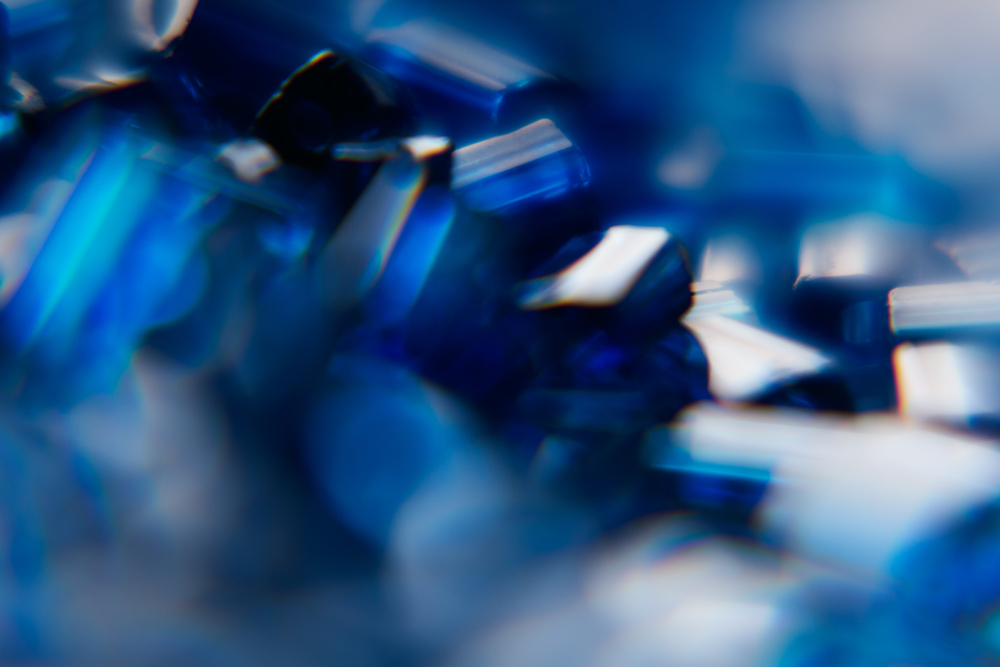Although often considered a precious gemstone, sapphire is a form of the common material Aluminium Oxide (Alumina – Al2O3), although unlike the alumina used in engineering ceramics, sapphire is the single crystal form of alumina. This single crystal structure leads to no grain boundaries or porosity and a material with a measured density which is close to the theoretical value for the pure Al2O3 material.

Image Credit: Shutterstock/Alina Yudina
Sapphire gemstones are naturally occurring, often alongside another form of pure aluminium oxide, ruby. The colour differences between sapphire and ruby being explained by the incorporation of the element chromium.
Since 1902 synthetic sapphire has been available following the discovery by the French chemist Auguste Verneuil that alumina powder directed through a high temperature flame can subsequently be deposited in the form of a “boule” of the material.
Machining of Sapphire
When sapphire is required it is usually “needed” and not “wanted”.
The “need” is usually due to all other material options being exhausted due to inadequate material properties.
Consequently, when sapphire is needed, the difficulty is not in the selection of the material but rather the ability to create the part in a configuration which is useful.
In any application where sapphire is “needed”, the material will need to be ground to some size and tolerance and possibly polished so that the material will be useful as intended.
As is often the case when faced with a difficult manufacturing challenge, it is always best to talk to someone with experience in order to succeed as quickly as possible.
Key Properties of Sapphire
The high hardness of sapphire and the ability to produce the material without dopants in a transparent single crystal form, permits the formation of “sapphire” which is transparent to light over a wide range of wavelengths.
The hardness of 2,300 Hv also ensures that the material is very scratch and wear resistant. It is complimented by the following indicative mechanical and physical properties which lead to a wide range of industrial uses.
| Property |
Value |
Notes |
| Mechanical Properties |
| Density |
3.97×103 kg/m3 |
|
| Tensile Strength |
2250 MPa |
as measured by a .25mm diameter filament at room temperature |
| Compressive Strength |
2950 MPa |
|
| Young’s Modulus |
4.7×105 MPa |
|
| Flexural Strength |
690 MPa |
|
| Thermal Properties |
| Melting Point |
2,053˚C |
|
| Coefficient of Linear Thermal Expansion |
5.3×10-6 /K (25˚C) |
Parallel to C axis |
| |
4.5×10-6 /K (25˚C) |
Perpendicular to C axis |
| Thermal Conductivity |
42W/mK (25˚C) |
|
| Electrical Properties |
|
|
| Resistivity |
1×1014 Ωm |
at ambient temp |
| |
1×109 Ωm |
at 500˚C |
| Dielectric Constant |
11.5 |
parallel to C axis (103 ~1010 Hz, 25˚C) |
| |
9.3 |
perpendicular to C axis (103 ~1010 Hz, 25˚C) |
| Dielectric strength |
4.8×10 4 KV/m (60Hz) |
|
Industrial Applications of Sapphire
Electronic Substrate Applications
Sapphire is attractive as a substrate material as it can be produced in relatively large dimensions is inert and can work at high temperatures. It is frequently used as a substrate for the epitaxial deposition of Silicon and Gallium Nitride.
- Insulating substrate applications in high-power, high-frequency CMOS integrated circuits. Often denoted as a silicon on sapphire or "SOS" or Silicon on Insulator “SOI” chip.
- Substrates for the deposition and growth of carbon nanotubes and Zinc Oxide nanowires
Sapphire in Display Devices
In the consumer sector the use of sapphire as a premium transparent watch face material is widely acknowledged, but there are many other display type applications:
- Sapphire windows can be used in both long and short wavelength environments (Infra Red and Ultra Violet) and also where high temperature and corrosion resistance is required.
- Forward Looking Infra Red (FLIR) optics and sensor devices.
- POS windows ( point of sale windows) for bar code scanning
Sapphire in Mechanical Components and Cutting Tools
The high hardness, stiffness and single crystal structure lead to applications of sapphire components in many industrial or engineering components. Some examples are provided below:
- In aerospace applications where a window may be subjected to a high degree of impact erosion, sapphire windows are often the preferred choice due to the higher scratch resistance when compared to conventional glass windows.
- Analytical equipment applications are another common area where the transparency and strength is important but also in many applications the resistance of sapphire to hydrofluoric or phosphoric acid is also significant.
- Nozzles in sandblasting and water jet cutting.
Medical Applications of Sapphire
In medical applications the fine microstructure, load bearing capabilities and light transmission qualities of sapphire present interesting options to the medical component designer:
- Surgical Tips and systems using laser transmission.
- Biomedical implants used in dental applications
- In endoscopic inspection tools sapphire is often used as a window material.
- High sharpness cutting blades. The fine microstructure of sapphire combined with skilled machining and polishing techniques leads to the production of ultra fine blade and cutter edges.
- Sapphire is also non- thrombogenic (does not cause blood clots)
Insaco
If you are considering an engineering application that you feel may be suited to sapphire then Insaco with 65 years of experience is second to none.
They have many decades of experience on machining and polishing sapphire materials for a wide range of applications and have been involved in many of the applications above when they were in their infancy.
Presently they have an 85,000 ft2 facility with more than 300 machine tools capable of grinding and polishing glass ceramics and other ceramic materials to useful geometries and tolerances.
Sources
.jpg)
This information has been sourced, reviewed and adapted from materials provided by INSACO Inc.
For more information on this source, please visit INSACO Inc.